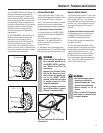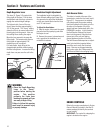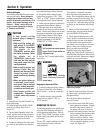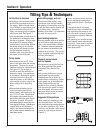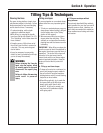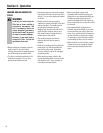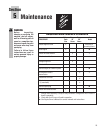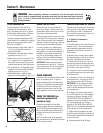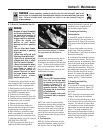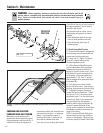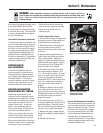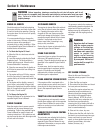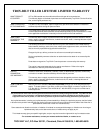
Section 5: Maintenance
WARNING Before inspecting, cleaning or servicing the unit, shut off engine, wait for all
parts to come to a complete stop, disconnect spark plug wire and move wire away from spark
plug. Failure to follow these instructions can result in serious personal injury or
property damage.
from turning by gripping the upper end of
the threaded adjuster (B) with pliers.
6. Repeat Step 3 to measure the length
of the clutch bail spring. Once the length
is correct, retighten the hex nut against
the top of the adjuster.
Forward Belt Replacement Information
If the drive belt needs to be replaced, see
your local authorized dealer or phone the
factory as instructed on Page 2. Refer to
the Parts List in the back of this manual
for correct components Use only OEM
(Original Equipment Manufacturer) fre-
placement belts. A substitute belt may
not perform satisfactorily. The procedure
requires average mechanical ability and
commonly available tools.
FORWARD CLUTCH
BAIL ADJUSTMENT
If the Forward Clutch Bail does not
function properly, first check that the
forward drive belt is adjusted properly
(see “Checking and Adjusting Forward
Drive Belt Tension”). If this fails to
correct the problem, contact the factory
technical service department or your
authorized dealer for service advice.
CHECKING AND ADJUSTING
REVERSE DRIVE BELT TENSION
Maintaining correct tension on the
reverse drive belt is important to good
performance and long belt life. A loose
belt will slip on the engine and transmis-
sion pulleys and cause the tines and
wheels to slow down – or stop com-
pletely – even though the engine is
running at full speed. A loose belt can
also result in premature belt wear.
If there is no reverse action when the
Reverse Clutch Control knob is pulled
out, then the belt tension is too loose.
When checking belt tension, also check
the belt for cracks, cuts or frayed edges
and replace it as soon as possible.
• Check belt tension after the first two
hours of break-in operation (new belt).
• Check belt tension after every 10
operating hours.
To Check Reverse Belt Tension:
1. Be sure that the engine is stopped and
the spark plug wire is disconnected and
moved away from the spark plug.
2. Remove the screw in the plastic belt
cover and slide the cover (which is
attached to the forward clutch cable) out
of the way.
3. Have an assistant pull the Reverse
Clutch Control knob all the way out and
hold it in that position. Measure the
length of the cable wire between the end
of the threaded cable adjuster (A, Figure
5-5) and the end of the Z-fitting (B) to
which the cable wire is attached.
4. The belt tension is ideal if the cable
wire length measures between 1/8" to
1/4". If the length is less than 1/8" (and if
there is no reverse action when the tiller
is running), then make the following
adjustments. NOTE: If the length is more
than 1/4", no adjustment is needed, as
long as the reverse action functions
properly.
5. Release the Reverse Clutch Control
knob. Unthread the inner jam nut (C,
Figure 5-6) one to two turns and pull the
threaded cable adjuster (A, Figure 5-6) to
the left until the inner jam nut rests
against the bracket.
6. Prevent the inner jam nut (C) from
turning and tighten the outer jam nut (D)
against the bracket. Prevent the outer
jam nut (D) from turning and tighten the
inner jam nut (C) against the bracket.
7. Measure the gap by repeating Step 3.
Readjust as needed by repeating Steps 5
and 6.
8. Reinstall the belt cover.
Reverse Belt Replacement Information
If the drive belt needs to be replaced, see
your local authorized dealer or phone the
factory as instructed on Page 2. Refer to
the Parts List in the back of this manual
for correct components Use only OEM
(Original Equipment Manufacturer) fre-
placement belts. A substitute belt may
not perform satisfactorily. The procedure
requires average mechanical ability and
commonly available tools.
Figure 5-5: Measure cable wire length to
check for correct reverse belt tension.
A B
Figure 5-6: Move threaded
adjuster (A) to left to
increase belt tension.
D
C
A
23



